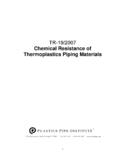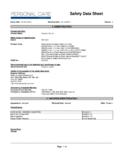Transcription of Bug Juice Material Safety Data Sheet
1 M a t e r i a l S a f e t y D a t a S h e e t 1. chemical PRODUCT and COMPANY IDENTIFICATION Walla Walla Environmental, Inc. 4 West Rees Ave. Walla Walla, Wa 99362 UNITED STATES OF AMERICA Emergency Telephone Number: In case of medical, environmental or transportation emergencies or inquiries, call: 1-800-247-9011 Product Name: BUG- Juice INSECTICIDE PAINT ADDITIVE chemical Name: Mixture; active ingredient, deltamethrin* Version Date: July 1, 2003 Page: 1 of 6 MSDS Number : 47332-11 * chemical NAME: Mixture; active ingredient, deltamethrin: (s)-alpha-cyano-3-phenoxybenzyl-(1R,3R)- 3-(2-2-dibromovinyl) -2,2-dimethyl-cylcopropanecarboxylate PRODUCT DESCRIPTION: BUG Juice concentrate is an insecticide additive for latex paint, oil base paint, stains and sealers. 2. COMPOSITION / INFORMATION ON INGREDIENTS Component CAS number % Deltamethrin 52918-63-5 Other ingredients This product contains no hazardous inert ingredients as definned by the OSHA Hazard Communications Standard (29 CFR ) or WHMIS regulations.
2 3. HAZARDS IDENTIFICATION EMERGENCY OVERVIEW: A white odorless liquid. Contact with product may result in transient tingling and reddening of the skin. This product is extremely toxic to fish and aquatic invertebrates. POTENTIAL HEALTH EFFECTS SIGNS AND SYMPTOMS OF EXPOSURE: Acute overexposure may result in respiratory irritation and transient paresthesia. It has produced ataxia, salivation, tremors, convulsions and respiratory depression in laboratory animal tests. IMMEDIATE EFFECTS SKIN: Contact with product may result in transient tingling and reddening of the skin. EYES: May cause slight irritation. INHALATION: Harmful if inhaled. 4. FIRST AID MEASURES After contact with eyes: Flush eyes with plenty of water. Get medical attention ifirritation persists. After inhalation: Remove victim to fresh air. If not breathing, giveartificial respiration, preferably mouth-to-mouth.
3 Get medical attention. 5. FIRE FIGHTING MEASURES FLAMMABLE PROPERTIES Flash point: Does not flash Advice on protection against fire and explosion: FLAMMABILITY CLASSIFICATION/RATING: NFPA/OSHA Class: IIIB NFPA Rating (Fire): 1 Page: 2 of 5 Walla Walla Environmental BUG Juice MSDS Suitable extinguishing media: Carbon dioxide, dry chemical , foam or water. Extinguishing media that must not be used for Safety reasons: FIRE FIGHTING INSTRUCTIONS: As in any fire, wear self-contained breathing apparatus pressure-demand, MSHA/NIOSH approved (or equivalent) and full protective gear. Keep upwind. Isolate hazard area. Avoid inhalation of smoke and fumes. Use water or foam to reduce fumes. Do not touch spilled Material . If possible, move containers from area. Extinguish only if flow can be stopped. Use flooding amounts of water as a fog. Cool containers with flooding amounts of water from as far a distance as possible.
4 Avoid breathing vapors. 6. ACCIDENTAL RELEASE MEASURES GENERAL AND DISPOSAL: Use proper protective equipment to minimize personal exposure (see Section 8). Take all necessary action to prevent and to remedy the adverse effect of the spill. Ensure that the disposal is in compliance with all Federal, State/Provincial, and local regulations (see Section 13 for applicable RCRA Number). Refer to Section 15 for applicable Reportable Quantity (RQ) and other regulatory requirements. Additional information: LAND SPILL OR LEAK Small Spills: Absorb with an inert absorbent Material such as granular clay, saw dust, or pet litter. Sweep up carefully while avoiding the formation of a dust cloud. Place in an approved chemical waste container for disposal. Rinse spill area with small amount of soapy water. Contain and absorb the rinsate with inert absorbents and place into the same disposal container.
5 Area can be washed with water to remove the last trace residue. Do not allow water to contaminate water supplies or sewers. Large Spills: Eliminate all ignition sources. Stop leak if you can do so without coming into contact with spilled Material . Dike far ahead of liquid spill for later disposal. All equipment used to clean up spill should be grounded. Additional information: Prevent entry into waterways, sewers, basements or confined areas. Inform appropriate authorities immediately if contamination occurs. Contact Walla Walla Environmental for further assistance if necessary. 7. HANDLING and STORAGE Handling: .Avoid breathing vapors or spray mist. Storage: Do not contaminate water, food or feed by storage. Store in a cool, dry place. 8. EXPOSURE CONTROLS / PERSONAL PROTECTION Additional advice on system design: ENGINEERING CONTROLS Control airborne concentrations below the appropriate exposure guideline (see below for any applicable OSHA/ACGIH Exposure Limits).
6 Local exhaust ventilation may be necessary. Hygiene measures: Wash thoroughly after handling. Avoid skin contact. Eye protection: Wear Safety glasses. Respiratory protection: Ensure good ventilation.. 9. PHYSICAL and chemical PROPERTIES APPEARANCE: A white liquid ODOR: Odorless BASIC PHYSICAL PROPERTIES PHYSICAL STATE: Liquid PH: in suspension VAPOR PRESSURE: Not available VAPOR DENSITY (AIR=1): Not available Page: 3 of 5 Walla Walla Environmental BUG Juice MSDS EVAPORATION RATE (BUTYL ACETATE = 1): Not available SPECIFIC GRAVITY OR DENSITY: @ 200C PACKING (BULK) DENSITY: Not available BOILING POINT/RANGE: Not available MELTING/FREEZING POINT RANGE: Not available SOLUBILITY (IN WATER): Suspends SOLUBILITY IN SOLVENTS/OIL (SPECIFIED): Not available DUST EXPLOSION SEVERITY data : Not applicable MINIMUM IGNITION ENERGY (MJ): Not available MINIMUM EXPLOSION CONCENTRATION (MEC): Not available LIMITED OXYGEN CONCENTRATION (LOC): Not available VISCOSITY: 1650 mPa's @ 200 C 10.
7 STABILITY and REACTIVITY chemical STABILITY: Stable INCOMPATIBILITY: Strong oxidizing and reducing agents. HAZARDOUS DECOMPOSITION PRODUCTS: Thermal decomposition products might include carbon monoxide and carbon dioxide. HAZARDOUS POLYMERIZATION: Will not occur 11. TOXICOLOGICAL INFORMATION THE FOLLOWING data WERE DEVELOPED WITH: DELTAMETHRIN TECHNICAL ACUTE TOXICITY ORAL LD50 (rat): > 15,000 mg/kg (practically non-toxic) DERMAL LD50 (rabbit): > 10,000 mg/kg (practically non-toxic) INHALATION LC50 (rat, 4hr): mg/L (slightly toxic) EYE IRRITATION (rabbit): non-irritating (Max. Avg. Score = ) SKIN IRRITATION (rabbit): non-irritating (Primary Irr. Index = ) SKIN SENSITIZATION (guinea pig): non-sensitizing NOTE: The severity classifications listed above are those of Walla Walla Environmental, and, particularly for eye irritation, may not always coincide with EPA-mandated Precautionary Statements.
8 THE FOLLOWING data WERE DEVELOPED WITH: Bug Juice , the active ingredient CHRONIC TOXICITY AND CARCINOGENICITY General neurological symptoms were exhibited in studies with rats, mice and dogs. These symptoms included unsteadiness, abnormal gait, tremors and liquid feces. No histopathologic findings were observed except some signs of slight hepatotoxicity in mice. No Observable Effect Levels (NOEL's) were 1 mg/kg/day in the 2-year rat and dog studies. The NOEL for the 2-year mouse study was approximately 12 mg/kg/day. Bug Juice was not carcinogenic in rats or mice. REPRODUCTIVE AND DEVELOPMENTAL TOXICITY No developmental effects were observed in studies with rabbits in the absence of maternal toxicity. The development NOEL for the rat study was 11 mg/kg/day (highest dose tested). The developmental NOEL in rabbits was 25 mg/kg/day. A 2-generation reproductive study with rats produced clinical signs of toxicity, reduced body weight gain and mortality in both parents and offspring.
9 The parental and reproductive (offspring) NOEL's were 80 ppm, which is equivalent to approximately 4 mg/kg/day for adults and 18 mg/kg/day for the offspring. Page: 4 of 5 Walla Walla Environmental BUG Juice MSDS NEUROTOXICITY BUG Juice does not inhibit acetylcholinesterase. Neurobehavioral effects including unsteadiness, excessive salivation, vomiting, liquid feces, uncoordinated movement, tremors, spasodic convulsions which are typically related to Central Nervous System (CNS) stimulation, were observed in some studies. The NOEL for these studies was 1 mg/kg/day or higher. MUTAGENICITY (GENETIC EFFECTS) No evidence of genotoxicity was observed in a battery of in vitro and in vivo studies. 12. ECOLOGICAL INFORMATION ENVIRONMENTAL PRECAUTIONS This product is extremely toxic to fish and aquatic invertebrates. Do not discharge effluent containing this product into lakes, streams, ponds, estuaries, oceans or other waters unless in accordance with the requirements of a National Pollutant Discharge Elimination System (NPDES) permit and the permitting authority has been notified in writing prior to discharge.
10 Do not discharge effluent containing this product to sewer systems without previously notifying the local sewage treatment plant authority. For guidance contact your State Water Board or Regional Office. THE FOLLOWING data WERE DEVELOPED WITH: DELTAMETHRIN TECHNICAL ECOLOGICAL TOXICITY Deltamethrin Technical is highly toxic to fish and other aquatic species, however, the toxicity to avian species is relatively low. Avian Bobwhite Quail (LD50): > 2250 mg/kg Bobwhite Quail (dietary LC50): > 5620 ppm Mallard Duck (dietary LC50): > 8039 ppm Quail Reproduction (repro NOEL): 450 ppm Duck Reproduction (repro NOEL): 450 ppm Aquatic Rainbow Trout (96-Hour LC50): ppb Bluegill Sunfish (96-Hour LC50): ppb Sheepshead Minnow (96-Hour LC50): ppb Eastern Oyster (96-Hour LC50): ppb Mysid Shrimp (96-Hour LC50): ppt; NOEC = 1. ppt Mollusk Shell Deposition (EC50): ppb Chronic Toxicity-Fathead Minnow: MATC = 24 ppt Chronic Daphnia Toxicity: MATC = ppt ENVIRONMENTAL FATE The major routes of dissipation are soil binding and soil microbial degradation.






